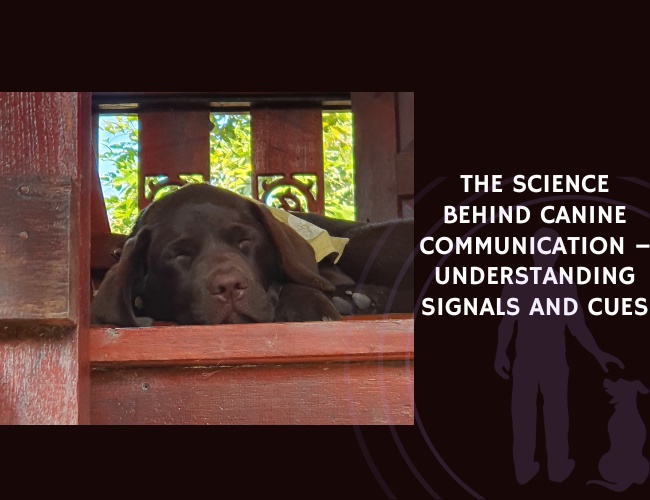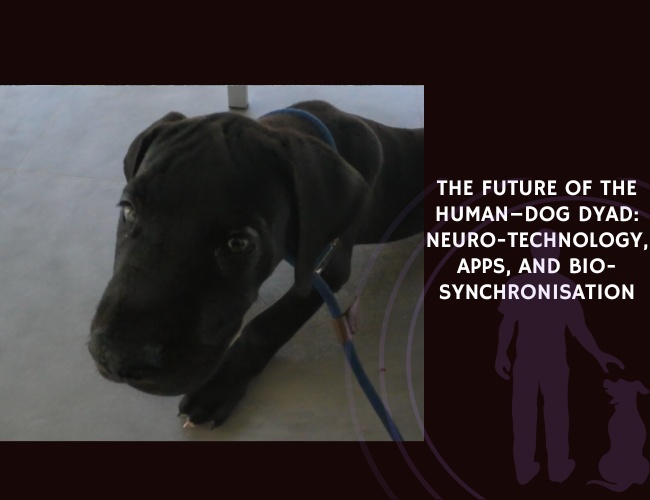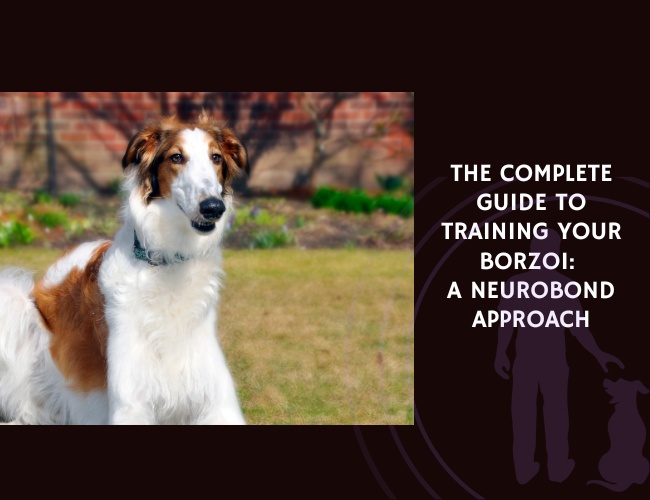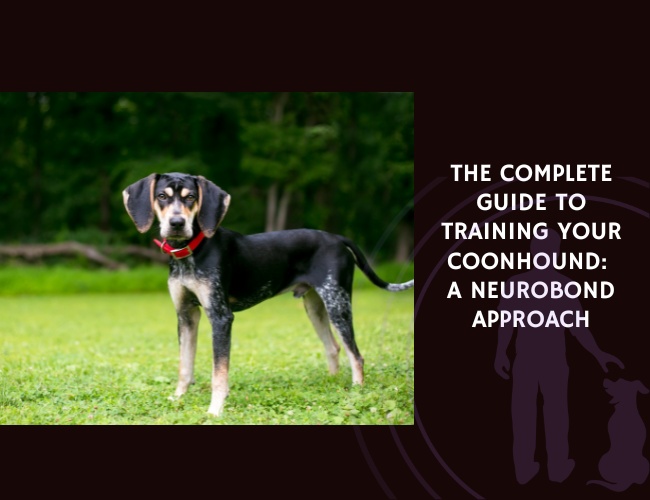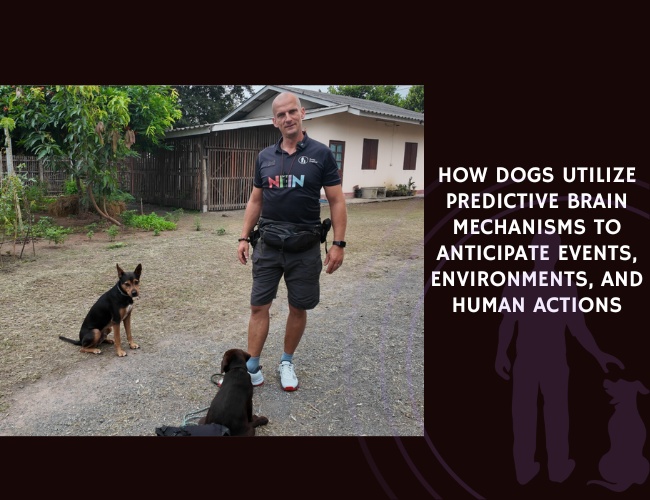Introduction to Canine Communication
Overview of the Importance of Understanding Dog Communication
Understanding dog communication is essential for several reasons. First and foremost, it enhances the bond between dogs and their human companions. By accurately interpreting the signals dogs send, owners can respond appropriately, fostering better interactions and reducing confusion and frustration. This understanding is also critical for preventing misunderstandings, which can lead to undesirable behaviors or even aggression. Essentially, the more we understand how dogs communicate, the better we can cater to their needs and ensure their well-being.
Evolutionary Basis and Impact of Domestication on Communication Methods
Dogs have evolved from wolves, and this evolutionary path has significantly shaped their communication methods. Research indicates that domestication has markedly influenced how dogs communicate, differentiating them from their wild counterparts. While wolves depend heavily on group cohesion for survival, domesticated dogs have adapted to communicate effectively in a human-centered environment. This adaptation includes the ability to read and respond to human emotional cues and signals, which is a skill less developed in wild canines.
The process of domestication has led to enhanced abilities in dogs to interpret human cues and express their emotions in ways that are reciprocally understood by humans. For instance, the eyebrow movement seen in dogs, which creates a look of sadness, is an adaptation not prevalent in wolves and is thought to trigger a nurturing response from humans. These nuances demonstrate how closely interwoven the evolutionary path of dogs is with their interactions with humans.
Role of Communication in Strengthening Human-Dog Relationships
Communication plays a pivotal role in reinforcing and nurturing the bond between humans and dogs. When dogs and their human companions can communicate effectively, it leads to a more harmonious and fulfilling relationship. Dogs, through various means such as body language, vocalizations, and scent marking, convey their needs, emotions, and intentions. Humans who understand these signals can meet their dog’s needs more accurately, whether that be for affection, play, or space.
Moreover, positive reinforcement training based on understanding and interpreting these communication signals strengthens trust and mutual respect. For instance, when a dog learns that sitting on command leads to a positive reward, it enhances the dog’s willingness to communicate and cooperate with their human. Additionally, understanding the subtle signs of stress and discomfort in dogs can help prevent negative experiences, thus contributing to a positive and safe living environment for both parties.
As we delve further into the specific aspects of canine communication, it becomes clear just how intricate and important these signals are. Grasping these nuances is not only fascinating but also instrumental in enhancing our relationship with these remarkable creatures.
Visual Communication Signals
Tail Positions and Wagging Patterns
The tail is one of the most expressive parts of a dog’s body. Its position and movement can reveal a lot about a dog’s emotional state. For instance, a wagging tail typically signifies happiness or excitement. However, the context is crucial. A tail wagging slowly with a stiff body could indicate caution and possible aggression. Alternatively, a fast, wide wag often signals a friendly and relaxed dog. A low, tucked tail usually represents fear or submission, suggesting the dog is feeling threatened or anxious.
Ear Positions, Facial Expressions, and Eye Contact
Ears: Dogs’ ears are highly expressive. When a dog’s ears are raised and perked up, it can indicate alertness, curiosity, or interest. Flattened ears, on the other hand, often signal fear or submission. Understanding these signals can help you gauge how your dog is feeling in various situations.
Facial Expressions: Dogs frequently use their faces to communicate. Raised eyebrows or a tense facial expression can suggest stress or anxiety. Lip licking and yawning can also be signs that a dog is feeling uneasy. These subtle cues can be easy to miss but are important indicators of your dog’s emotional state.
Eye Contact and Blinking: Direct eye contact can be perceived as a sign of dominance or challenge. Conversely, soft blinking and averting gaze can show trust and submission. Noticing these cues can help you understand and respond to your dog’s needs effectively.
Body Posture and Movement Patterns
Dogs use their whole body to communicate. A relaxed stance, with a loose body and wagging tail, indicates a calm and happy dog. When a dog’s body stiffens, it could be signaling tension or aggression. For example, a dog standing stiffly with its weight shifted forward is likely feeling threatened or ready to defend itself. On the flip side, a dog that rolls over to show its belly is displaying submission and trust.
Understanding these visual signals is essential for building a strong and respectful relationship with your dog. By decoding these cues, you can prevent misunderstandings and enhance your ability to meet your dog’s needs, creating a harmonious living environment.
Vocal Communication Methods
When it comes to understanding our canine companions, vocal communication is indispensable. It’s fascinating to observe how dogs use barks, growls, and howls to express themselves. Each type of vocalization serves a specific purpose and provides insights into a dog’s emotional state and intentions.
Different Types of Barks and Their Specific Purposes
Barking is the most common form of vocal communication in dogs. By tuning into the nuances of a dog’s barks, you can decipher their needs and emotions.
- Alert Barks: Sharp, rapid barks meant to alert their owners to potential danger or the presence of a stranger. These barks signal vigilance and protection.
- Attention-Seeking Barks: Repeated, moderate barks typically meant to get attention. Whether they need food, a walk, or just some company, these barks are their way of saying, “Look at me!”
- Playful Barks: Short, high-pitched barks often accompanied by a wagging tail and playful postures. These barks signal friendliness and a desire to engage in play.
- Fearful Barks: High-pitched and often mixed with whining, these barks indicate anxiety or fear. Dogs might stand back, with their tails tucked and ears flattened.
- Separation Anxiety Barks: Prolonged, repetitive barks typically occurring when a dog is left alone. They signal distress and the need for companionship.
Meaning Behind Growls in Various Contexts
Growling can be misunderstood if taken at face value. It’s essential to observe the context in which a dog growls to understand its meaning.
- Defensive Growls: Typically low, rumbling growls used to convey discomfort or a desire for space. A dog might exhibit defensive growling when cornered or feeling threatened.
- Playful Growls: Higher-pitched and mixed with barks, these growls are common during play. They signal excitement rather than aggression.
- Warning Growls: Deep and sustained growls, usually signaling a warning. These growls mean “back off” and are often accompanied by a tense body, raised hackles, and direct eye contact.
Purpose and Significance of Howling in Pack Behavior
Howling is more than just a haunting sound; it serves critical functions within a pack.
- Communication Over Distance: Dogs howl to communicate with other pack members over long distances. In the wild, wolves use howling to coordinate movements and maintain pack cohesion.
- Responding to Environmental Stimuli: Howls can be triggered by sounds like sirens or other dogs’ howls. This vocal instinct is deeply rooted in their ancestral behavior.
- Bonding Rituals: Howling also strengthens social bonds within a group. When dogs howl together, they reaffirm their connection and synchronize their social activities.
Understanding these vocal signals allows a deeper connection with your furry friend. By interpreting their barks, growls, and howls, you can respond appropriately to their needs and emotions. This enriches your relationship and ensures better care and mutual respect.
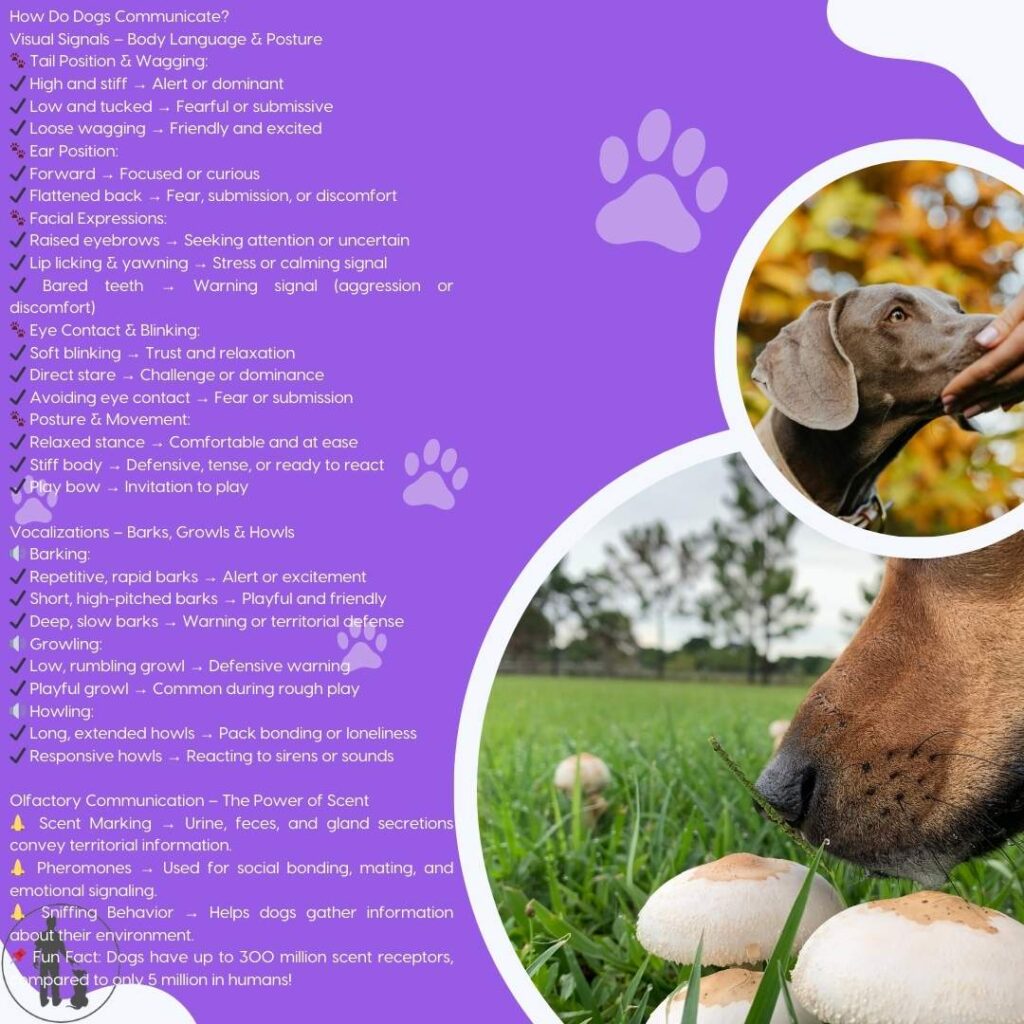
The Power of Scent Communication
When it comes to communicating, dogs have a remarkable tool at their disposal: their extraordinary sense of smell. Scent plays a critical role in how dogs share information, understand their environment, and interact with both dogs and humans.
Scent Marking: Leaving Invisible Messages
Dogs often use scent marking as a way to convey vital information. This is usually done through urine and feces, but it can also involve secretions from specialized glands. By leaving their scent in a particular area, dogs can communicate their identity, territory, and even reproductive status. Think of it as a kind of olfactory business card, letting other dogs know who has been there and perhaps who is still nearby.
Scent marking isn’t just about marking territory; it’s a way for dogs to leave behind a lasting message that can be “read” by others long after the original sender has moved on. Intriguingly, the scent markings can contain a wealth of information about the dog, ranging from its age and sex to its health and emotional state.
Pheromones: The Emotional Signposts
Pheromones are chemical signals that play a crucial role in dog communication. These invisible messengers can convey a dog’s emotional state to other dogs and even to humans. For example, a dog that is stressed or anxious may release specific pheromones that other dogs can pick up on, signaling that they should approach with caution or avoid the stressed individual altogether. Conversely, pheromones released by a content and relaxed dog can contribute to a calm and peaceful atmosphere.
Understanding pheromones and their impact can be particularly useful for dog owners. Knowing that a dog is agitated or anxious because of the pheromones it is releasing can prompt a more compassionate and considered response, assisting in calming the dog and addressing its needs.
Incredible Sense of Smell: A World in Technicolor
Dogs have an extraordinary sense of smell, capable of detecting scents at concentrations nearly 100 million times lower than humans can perceive. This acute olfactory ability offers dogs a unique perspective of the world around them. They can use their noses to detect individual components of complex scents, allowing them to track other animals, find food, and even identify diseases in humans.
The social interactions that stem from their incredible sense of smell are fascinating. Dogs recognize and remember the scent profiles of other dogs and people, enabling complex social structures and relationships to form based on these olfactory cues. In dog parks or other social settings, dogs often engage in mutual sniffing, a behavior that helps them gather information and establish relationships.
By decoding these intricate layers of scent-based communication, we can deepen our connection with our canine companions, ensuring their emotional and social needs are met.
Transitioning to the Next Aspect
Having explored the intricate world of scent communication, it’s clear that dogs rely heavily on their sense of smell to navigate their social environments. This forms a foundation upon which other communication methods build, enhancing the multi-faceted interaction dogs have with their surroundings and with humans.
Understanding these olfactory cues provides a richer perspective on what drives a dog’s interactions and behaviors.
Neurological Basis of Dog Communication
Understanding the neurological foundation of canine communication offers insights into how dogs perceive and interpret various social signals. This is essential for enhancing human-dog relationships and deciphering canine behavioral patterns.
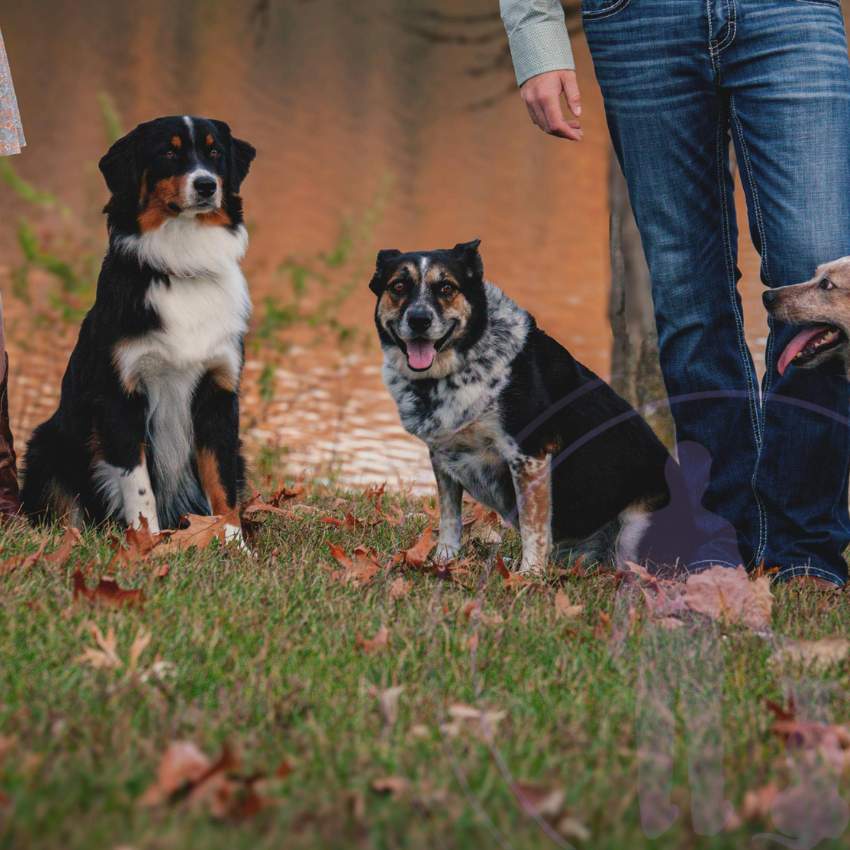
Brain Processing Mechanisms
Dogs possess specialized brain regions dedicated to processing social signals. The amygdala, for instance, plays a crucial role in emotional interpretation. It helps dogs identify whether signals from other dogs or humans are friendly, threatening, or neutral. This ability to process emotional cues is vital for dogs to navigate their social environments effectively.
Role of Mirror Neurons
Mirror neurons, found in the brains of both dogs and humans, enable the imitation of behaviors and facilitate social learning. These neurons fire not only when a dog performs an action but also when it observes another dog or human performing the same action. This mechanism allows dogs to learn from observing others and to empathize with their human companions.
Findings from fMRI Studies
Functional Magnetic Resonance Imaging (fMRI) studies provide a window into the canine brain’s responses to human cues. These studies have shown that dogs respond differently to various human voices and emotional cues. For instance, dogs’ brains show distinct patterns of activity when they hear their owners’ voices compared to strangers, indicating the depth of their bond and their ability to recognize familiar sounds. Moreover, dogs can differentiate between happy and angry human voices, which influences their behavior and responses.
Exploring these neurobiological aspects sheds light on the sophisticated ways dogs interact with both their canine counterparts and human friends, enriching our understanding of their communication patterns.
Dog-Human Communication
Dogs’ Ability to Interpret Human Body Language and Emotional Cues
One of the most fascinating aspects of a dog’s communication ability is their skill in interpreting human body language and emotional signals. Dogs have evolved to become highly attuned to human behaviors and can read subtle cues that may go unnoticed by other animals. For instance, dogs can differentiate between positive and negative emotions just by observing human facial expressions and body posture. This keen sense allows them to respond appropriately to a variety of human emotions, whether it be comfort during sadness or excitement during joy.
Dogs are also adept at interpreting vocal tones. They can detect changes in pitch and intensity, which helps them understand the emotional context of words spoken by their human companions. This skill is particularly useful in training and daily interactions, as it enhances the bond between dogs and their owners. Essentially, this ability to pick up on human cues is crucial for effective interspecies communication.
Adaptation of Communication Strategies in Different Environments
Dogs possess an incredible ability to adapt their communication strategies based on their environment and social contexts. For example, a dog living in a high-traffic urban environment may develop more nuanced vocalizations and body language to navigate the hustle and bustle of the city. On the other hand, dogs in more rural settings might rely more heavily on scent marking and visual signals due to the open space and different hazards.
Additionally, dogs living with multiple pets or in a large family might adopt different communication strategies to interact with each family member effectively. Each environment presents unique challenges, and dogs show remarkable flexibility in adjusting their behaviors to ensure clear communication and social harmony.
Impact of Training on Interspecies Communication Effectiveness
Training plays a vital role in enhancing the communication effectiveness between dogs and humans. Positive reinforcement training, for instance, not only teaches dogs specific commands but also develops their ability to interpret and respond to human signals more accurately. This type of training leverages a dog’s natural ability to understand human cues and directs it towards constructive behavior.
Moreover, training can significantly improve a dog’s adaptability in various settings, such as public spaces, homes with children, or multi-pet households. Well-trained dogs are better equipped to handle diverse social situations, making them more confident and less prone to anxiety. This, in turn, fosters a stronger bond between the dog and its owner, enhancing mutual understanding and companionship.
Understanding these facets of dog-human communication provides a foundation for a deeper relationship with our canine companions. By recognizing and effectively responding to the signals they give us, we can create a more harmonious and enriching environment for both humans and dogs.
Social Learning and Development
Importance of Early Socialization in Developing Communication Skills
Understanding the role of early socialization in dogs can help in fostering well-adjusted and communicative pets. During the critical period of socialization, typically between 3 and 14 weeks of age, puppies exposed to various environments, people, and other dogs develop robust communication skills. This exposure helps them learn essential social cues, making them better at interpreting and responding to human interactions as well as to other dogs.
Lack of proper socialization can lead to communication deficiencies, making dogs more likely to develop anxiety, aggressiveness, or other behavioral issues. Therefore, incorporating structured socialization through exposure to different stimuli and controlled interactions is paramount for developing their communication repertoire.
Role of Observational Learning in Enhancing Communication Abilities
Dogs also learn a great deal by observing others. Observational learning, particularly from human companions and other dogs, enhances their communication ability. Studies show that dogs are adept at mimicking behaviors, actions, and even emotional responses by watching their human caregivers and canine peers.
For instance, a dog may learn to fetch a ball by observing another dog perform the task. This form of learning not only improves their skill set but also deepens their social bonds with their human families by aligning behaviors in a more harmonious way.
Influence of Pack Dynamics on Communication Development
Pack dynamics play a critical role in shaping a dog’s social communication capabilities. In a pack, which can range from a group of dogs to a family household including humans, roles and hierarchies influence behavior and interactions.
Strong leadership, usually exhibited by a main caregiver or a dominant dog, sets the tone for communication within the pack. Dogs learn to follow commands, respect boundaries, and engage appropriately with each other through structured hierarchy and defined roles.
Such structured settings allow dogs to develop a clear understanding of social order, which in turn supports effective communication. For instance, younger dogs or lower-ranking pack members learn to display submissive behaviors around higher-ranking members, thus maintaining harmony and reducing conflicts.
By appreciating how early socialization, observational learning, and pack dynamics contribute to communication development, we can better support our canine companions in becoming well-rounded social beings.
Ultimately, by fostering their social environments and providing ample learning opportunities, we enhance their ability to communicate effectively, benefiting both the dogs and their human families. Understanding this context can enrich our approach to training, care, and daily interactions with our dogs, thus fostering a deeper bond and mutual respect.
Comparative Communication Analysis
Key Differences Between Dog and Wolf Communication Patterns
One of the most intriguing aspects when comparing dogs and wolves is how domestication has influenced their communication methods. While dogs and wolves share a common ancestor, their evolutionary paths have diverged significantly.
Wolves predominantly rely on vocalizations and body language to communicate within their pack. Their communication is geared towards maintaining social order and ensuring survival. For instance, wolves use howls to coordinate hunting and establish territory.
Dogs, on the other hand, have adapted their communication to interact more effectively with humans. This adaptation has resulted in a broader range of vocalizations and body language cues that cater specifically to human understanding. Domesticated dogs have developed a greater ability to interpret human gestures and emotional expressions, which are less critical in wolf packs.
Comparison of Dog-Dog versus Dog-Human Interaction Styles

Another fascinating difference lies in how dogs communicate with each other compared to how they interact with humans. Dogs adapt their communication strategies based on their audience. When interacting with other dogs, they rely heavily on body language, such as tail positions, ear movements, and facial expressions. These signals help establish social hierarchies and maintain pack harmony.
In contrast, when communicating with humans, dogs use a combination of vocalizations and visual signals. They have learned to pay close attention to human facial expressions, body language, and tone of voice. This ability allows them to understand and respond to human commands and emotions effectively. Research indicates that dogs can differentiate between positive and negative emotional signals from humans, which influences their responses.
Breed-Specific Variations in Communication Methods
Interestingly, different dog breeds exhibit unique communication styles influenced by their historical roles and selective breeding practices. For instance, herding breeds like Border Collies are particularly adept at interpreting human commands and working collaboratively during tasks. These breeds use eye contact and body movements to control livestock, showcasing their evolved communication skills.
On the other hand, breeds like Beagles rely more on olfactory signals due to their history as scent hounds. They use their extraordinary sense of smell to track scents and communicate through scent marking.
Understanding these breed-specific variations can help owners tailor their training and improve communication with their dogs. For example, using visual cues might be more effective for a Border Collie, while incorporating scent-related games and tasks could be better suited for a Beagle.
As a result, all these insights into canine communication highlight a diverse and complex system that dogs use to interact with their environment, other dogs, and humans. By appreciating these differences and nuances, we can build stronger, more understanding relationships with our canine companions, fostering better communication and deeper bonds.

